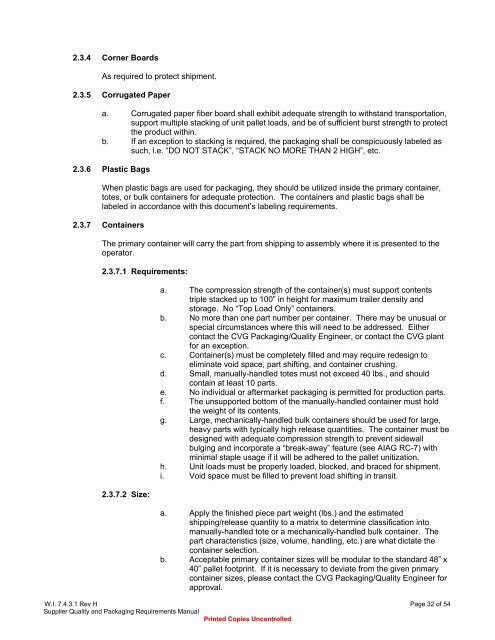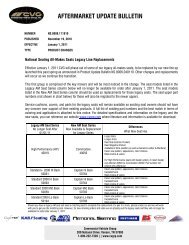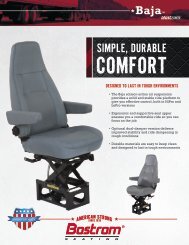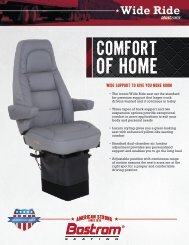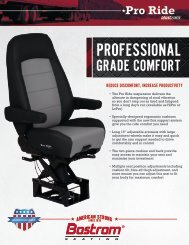supplier quality and packaging requirements manual - Commercial ...
supplier quality and packaging requirements manual - Commercial ...
supplier quality and packaging requirements manual - Commercial ...
Create successful ePaper yourself
Turn your PDF publications into a flip-book with our unique Google optimized e-Paper software.
2.3.4 Corner Boards<br />
As required to protect shipment.<br />
2.3.5 Corrugated Paper<br />
a. Corrugated paper fiber board shall exhibit adequate strength to withst<strong>and</strong> transportation,<br />
support multiple stacking of unit pallet loads, <strong>and</strong> be of sufficient burst strength to protect<br />
the product within.<br />
b. If an exception to stacking is required, the <strong>packaging</strong> shall be conspicuously labeled as<br />
such, i.e. “DO NOT STACK”, “STACK NO MORE THAN 2 HIGH”, etc.<br />
2.3.6 Plastic Bags<br />
When plastic bags are used for <strong>packaging</strong>, they should be utilized inside the primary container,<br />
totes, or bulk containers for adequate protection. The containers <strong>and</strong> plastic bags shall be<br />
labeled in accordance with this document’s labeling <strong>requirements</strong>.<br />
2.3.7 Containers<br />
The primary container will carry the part from shipping to assembly where it is presented to the<br />
operator.<br />
2.3.7.1 Requirements:<br />
2.3.7.2 Size:<br />
a. The compression strength of the container(s) must support contents<br />
triple stacked up to 100” in height for maximum trailer density <strong>and</strong><br />
storage. No “Top Load Only” containers.<br />
b. No more than one part number per container. There may be unusual or<br />
special circumstances where this will need to be addressed. Either<br />
contact the CVG Packaging/Quality Engineer, or contact the CVG plant<br />
for an exception.<br />
c. Container(s) must be completely filled <strong>and</strong> may require redesign to<br />
eliminate void space, part shifting, <strong>and</strong> container crushing.<br />
d. Small, <strong>manual</strong>ly-h<strong>and</strong>led totes must not exceed 40 lbs., <strong>and</strong> should<br />
contain at least 10 parts.<br />
e. No individual or aftermarket <strong>packaging</strong> is permitted for production parts.<br />
f. The unsupported bottom of the <strong>manual</strong>ly-h<strong>and</strong>led container must hold<br />
the weight of its contents.<br />
g. Large, mechanically-h<strong>and</strong>led bulk containers should be used for large,<br />
heavy parts with typically high release quantities. The container must be<br />
designed with adequate compression strength to prevent sidewall<br />
bulging <strong>and</strong> incorporate a “break-away” feature (see AIAG RC-7) with<br />
minimal staple usage if it will be adhered to the pallet unitization.<br />
h. Unit loads must be properly loaded, blocked, <strong>and</strong> braced for shipment.<br />
i. Void space must be filled to prevent load shifting in transit.<br />
a. Apply the finished piece part weight (lbs.) <strong>and</strong> the estimated<br />
shipping/release quantity to a matrix to determine classification into<br />
<strong>manual</strong>ly-h<strong>and</strong>led tote or a mechanically-h<strong>and</strong>led bulk container. The<br />
part characteristics (size, volume, h<strong>and</strong>ling, etc.) are what dictate the<br />
container selection.<br />
b. Acceptable primary container sizes will be modular to the st<strong>and</strong>ard 48” x<br />
40” pallet footprint. If it is necessary to deviate from the given primary<br />
container sizes, please contact the CVG Packaging/Quality Engineer for<br />
approval.<br />
W.I. 7.4.3.1 Rev H Page 32 of 54<br />
Supplier Quality <strong>and</strong> Packaging Requirements Manual<br />
Printed Copies Uncontrolled


